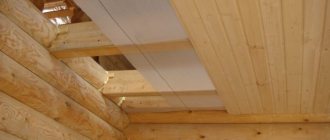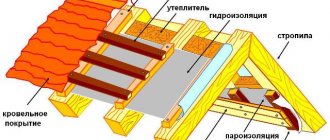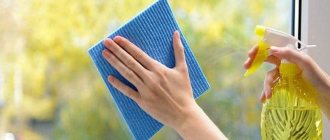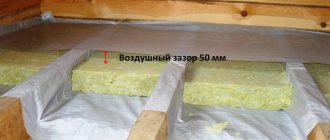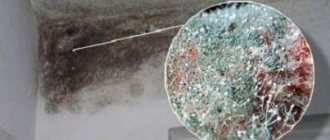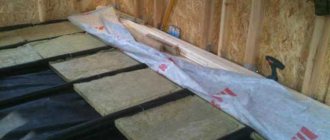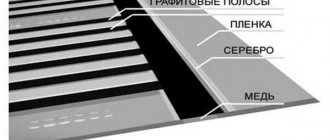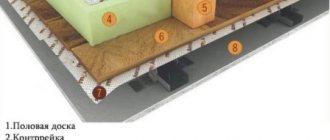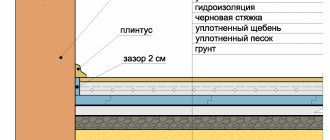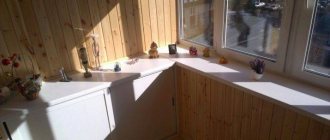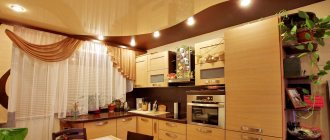A vapor barrier, which prevents moisture from penetrating into the thickness of the heat insulator and supporting structures, is a necessary element of the insulating “pie” of the walls, roof and floor of a private house.
Wanting to save money, some homeowners use polyethylene film as a vapor barrier - a budget material, but absolutely unsuitable as a vapor barrier for many reasons.
Why you can’t use polyethylene for vapor barrier
The main “disadvantage” of polyethylene as a vapor barrier is that this material does not allow air to pass through - it screens moisture well, but creates a greenhouse effect in the room.
Another fundamental drawback of such a vapor barrier in the “pie” of internal insulation of a house is the flow of condensate over the surface of the film and the accumulation of moisture on the floor. In addition, over time, polyethylene film undergoes destruction, becomes brittle and crumbles into small fragments, and due to its low tensile strength, it is often damaged during installation.
Types of vapor barrier films
If we talk about the main materials from which hydro-wind-vapour barriers are made, then there are two of them:
- polyethylene;
- polypropylene.
For example, the UTA company (Czech Republic) produces multilayer polyethylene films, and the domestic corporation GEXA produces polypropylene films (known under the brand name Izospan).
Also, all vapor barrier films can be divided into:
- single-layer polyethylene;
- specialized multilayer.
A single-layer polyethylene film for vapor barrier does not have a reinforcing layer, and it does not withstand high tensile loads, but even in some current standards, instead of a specialized vapor barrier, polyethylene is “registered” as the main material. And in Finnish frame houses, using “native” technology, 200 micron polyethylene is laid inside the walls to vapor barrier mineral wool.
Watch a video on how to install vapor barriers using 200 micron polyethylene film:
Specialized films consist of several layers:
- Reinforcing layer , which is made in the form of a grid of strips of base material. It is responsible for the strength to mechanical stress when attached to the supporting frame (or sheathing) and during operation of the structure.
- Polyethylene or polypropylene film is the second layer, which is responsible for vapor barrier.
- Lamination on the reverse side is available for most modifications of vapor barrier films. This increases vapor permeability, since the basic principle of operation of a vapor barrier film implies that the thicker the material, the less water vapor will “leak” through a unit surface area in a fixed period of time.
There are universal films that can be laid on either side of the insulation (for example, materials from the YUTAFOL N series).
There are films with an “asymmetrical” structure - one side of them has either a rough or reflective surface. The first option is called “anti-condensation” vapor barrier films. The second option is vapor barrier films with a foil surface (fourth layer), which reflects part of the thermal energy towards radiation.
When installing these types, it is important to know which side to lay the film on the insulation.
What is suitable for vapor barrier
The best option for vapor barrier when insulating a house is special vapor barrier membranes that prevent the penetration of moisture into the insulating layer, protect the structures and finishing of the building from destruction, extend the service life and improve the heat conservation of the house.
There are several types of vapor barrier membranes that are significantly superior to polyethylene films in strength, vapor resistance, and durability:
- Anti-condensation films. They are produced in the form of a non-woven fabric that effectively absorbs and retains condensation on its surface, which then evaporates naturally. The membranes are easy to install due to the absence of the need for a ventilation gap between the insulation and the finishing and are successfully used for the installation of pitched metal roofs, walls and ceilings of both insulated and irregularly heated non-insulated buildings.
- Superdiffuse membranes. Diffuse vapor shielding membranes are included in the insulating “pie” with low thermal conductivity, installing them without a ventilation gap.
- Thermal reflective films. Double-layer vapor barrier membranes with aluminum coating are used in the insulation system of wet rooms, which are characterized by temperature changes: baths, saunas, bathrooms. For example, R Termo Ondutis film reliably screens water vapor, returning 80% of the heat back into the room.
- Reinforced hydro- and vapor barrier films. Multifunctional membranes for protection against precipitation, moisture and condensation, which are used for insulating loggias, balconies, facades and roofs.
What can replace vapor barrier?
In order to make your home cozy and comfortable, first of all you need to take care of the correct temperature and acceptable humidity. Warm weather at home can be achieved with good heating and insulation, but controlling humidity can sometimes be very difficult. Plus, if there is excess humidity in the room, then all your efforts for comfort may be useless.
Wooden floor vapor barrier diagram.
Moisture has a negative impact on all wooden buildings. Steam is released from washing, mopping, cooking, showering and bathing, and then escapes beyond these premises. The steam pressure will be greater than atmospheric pressure, and it will press on the floor, walls and ceiling. And the difference in temperatures will lead to the formation of condensation, and then the water will gradually penetrate the tree and destroy it.
In this case, the materials will begin to rot, fungus will form and the entire structure will begin to deteriorate. Very often the floor in such a house is laid directly on the ground, and this will serve as an even greater cause for destruction. To avoid all these problems, it is necessary to make a vapor barrier layer that will protect the wood and insulation from moisture and will not stop allowing air to pass through.
We suggest you familiarize yourself with How to line a metal stove with bricks in a house: how to line a heating boiler, an iron stove, what kind of brick is best to use
Vapor barrier plays an important role in protecting the building envelope, preventing the penetration of water vapor into them, thereby preserving the thermal insulation properties of the insulation and extending the service life of the entire structure.
Unfortunately, consumers often attribute “miraculous” properties to vapor barriers that they do not possess. Let's destroy these myths...
What is the difference between vapor barrier and polyethylene film?
Vapor barrier is a material that does not allow even the smallest particles of water vapor to pass through in any direction, has good density, is not subject to the destructive effects of UV, and is easily installed with metal brackets or self-tapping screws. How does polyethylene differ from special film?
Judge for yourself.
Advantages of polyethylene:
- perfectly retains moisture and steam;
- costs less than branded vapor barriers.
Disadvantages of conventional film:
- under the influence of UV radiation it quickly deteriorates (cannot be used for external work);
- the strength of polyethylene is much lower than reinforced or membrane films, it is easier to tear, stretch, and is afraid of punctures and cuts;
- service life is lower than that of specialized vapor barrier;
- Thick polyethylene has sufficient strength, but weighs more than special films.
Accordingly, it is difficult to use such material on ceilings or walls.
Consider the installation of polyethylene film
In fact, the installation of a vapor barrier made of polyethylene film is no different from the process of installing a specialized vapor barrier. Since their main specificity is the protection of thermal insulation and wooden structures from the penetration of steam from residential premises, they are laid in front of the insulation.
This is how plastic film is installed on the ceiling
Wherever the film is used, it is laid horizontally from bottom to top, with overlaps of at least 15 cm.
The joints must be taped with reinforced tape to prevent steam from leaking through the cracks. In addition, another unshakable rule when installing a vapor barrier for any type of “pie” is that there must (!) be a ventilated air between the film and the insulation. If condensation somehow appears there, it will safely roll down the film and will not wet the insulation.
Place of the vapor barrier in the roofing “pie”:
- The roofing covering (metal tiles, sheet iron, slate) protects the interior of the house from climatic and atmospheric phenomena.
- Waterproofing - if atmospheric moisture penetrates under the roofing material, the film will protect the insulation and wooden structures from getting wet. The pairs “roof covering and waterproofing”, “waterproofing and insulation” should not be attached closely. Double-sided conrogrilling is used to provide ventilation gaps.
- Insulation. It is spread in several layers to ensure the required thickness of the casing. The risk of the appearance of “cold bridges” must be taken into account.
- Vapor barrier, like waterproofing, should be located at a distance of 2-3 cm from the insulation to ensure natural ventilation.
- Final finishing of the attic ceiling.
If we talk about internal walls or ceilings, the situation is similar:
- main wall/ceiling;
- lathing or frame made of metal profiles;
- insulation layer;
- vapor barrier film;
- plasterboard or other finishing material;
- final finishing.
As you understand, you can use regular polyethylene, but you need to use it extremely carefully due to its lower density and wear resistance.
We hope that the material was useful to you. We will be grateful if you share it on social networks. The buttons for this are below.
A vapor barrier made of polyethylene film creates a vapor barrier, as a result, the warm air of the room does not escape to the street. Such materials serve to protect the insulation from water vapor that forms inside the room. This is how moisture condensation is regulated in the area of the building envelope.
The harm of moisture accumulation in rooms is that as a result, spores of fungi, mold and other bacteria multiply. By using polyethylene film as a vapor barrier, this will be able to resist the penetration of water vapor. The material is made primarily of multilayer polyethylene.
Vapor barrier - what is it, how is it used?
In accordance with the standards for thermal protection of buildings, it is necessary to take measures to prevent wetting of the main and thermal insulation materials of enclosing structures. This function is performed by vapor and waterproofing films.
Water is always present in the gaseous state in the air. Under normal operating conditions in the warm season, it is generally accepted that the temperature and humidity outside and inside the house are almost the same. But even with the air conditioner on, when the partial pressure of water vapor outside is greater than inside, moisture transfer through the enclosing structures occurs without them getting wet.
In the cold season, the opposite situation occurs. In a heated room, the humidity level is higher than outside. Wet cleaning, water procedures, washing, washing dishes, domestic plants and animals, the person himself - all these are “generators” of steam. Natural exhaust ventilation cannot completely remove excess moisture. And as a result of a significant temperature difference, the partial pressure of vapor in the air inside the building is higher than outside.
Moist warm air penetrates the enclosing surfaces (floor, walls, ceiling, roof), and gradually cools as it passes out. In a certain place, when structural materials are saturated with vapor, conditions arise for condensation (transition of vapor into a liquid state). This conditional line, according to the SP 50.13330 standard, is called the plane of maximum moisture, and in popular form - the “dew point”.
Inside single-layer insulation structures made of dense materials, there is physically no place for condensation to fall out. The situation is the same for “light” materials with closed cells, but for a different reason - they have a very low water absorption coefficient (for example, penoplex). Any type of mineral wool, due to its loose structure, is hygroscopic (although the glass wool or stone wool fiber itself does not absorb moisture), and gets wet from both water and condensation.
When wet, mineral wool partially or completely loses its insulating properties. The permissible limit for the increase in moisture content of mineral wool slabs is 3% of their own weight. Therefore, it is protected from the outside from direct contact with water, and from the inside from the penetration of vapors.
For reference:
The JUTA company (UTA), in order to justify the need to use a vapor-moisture insulating film, gives the following arguments: mineral wool when moistened by 1% receives an increase in thermal conductivity of 32%, when moistened by 2.5% - 55%, when moistened by 5% - 100%.
Why do you need a vapor barrier?
Polyethylene vapor barrier
During the insulation process, the temperature affects the inner layer of the polyethylene film. There is still a small amount of water vapor in any room. Sometimes they form water droplets, this happens in certain cases:
- When excess moisture is fixed indoors.
- When the indoor temperature drops. If it decreases significantly, then the steam can no longer retain moisture.
Insulation with films may be necessary if the temperature inside the room is the same as outside. After installing a vapor barrier, steam will no longer turn into water. When the air temperature in the room begins to rise, the steam will disappear on its own.
Vapor barrier material is installed in those parts of the building where contact with cold air is felt most, namely on the floor of the first floor, the ceiling of the top floor or on the walls.
All this is done with the aim of insulating the room during the cold period. In addition, you will need high-quality installation of a vapor barrier film.
The difference between vapor barrier and waterproofing
Waterproofing roll materials protect against direct contact with water in its liquid state. Vapor barrier is necessary to limit the penetration of water vapor from the room into the insulation layer.
To briefly formulate how a vapor barrier film works, it is a multifunctional material that protects the insulation from the penetration of water into it in any state of aggregation. Any vapor barrier is a hydro vapor barrier film. In addition, it protects the room from insulation particles.
- The first difference between waterproofing and vapor barrier films is their location relative to the insulation. Waterproofing is installed on the street side and vapor barrier on the indoor side.
- The main purpose of the vapor-waterproofing film is to maintain a balance between the amount of water vapor penetrating into the insulation from the room and ventilated outside. And the waterproofing film must have a sufficiently high vapor permeability so that excess moisture can be evaporated from the insulation and construction materials (but without evaporation of insulation particles). Therefore, for external protection, vapor-permeable membrane films with micro-perforations are used. They are able to retain drops of water due to surface tension forces, but allow air and vapor to pass through.
Installation of vapor barrier
All further actions are thought through in advance, namely:
- The most suitable type of insulating material is selected.
- Installation work is underway.
- The film used is installed according to certain rules, this allows it not to disturb the structure of the building and other elements.
Most often, a vapor barrier is installed using polyethylene film. Many people don’t even know that there are substitutes for it. Quality indicators are 3 indicators:
- fire resistance;
- high strength;
- low thermal conductivity.
Below are the most common vapor barrier materials:
- Polyethylene with reinforced mesh. It comes either with or without perforated reinforcement. Products with perforations contain small holes that easily allow moisture to pass through. If there is no perforation, then there are no special holes. This material is quickly and easily installed with virtually no waste. Some films have a foil coating to help reflect heat. This coating is most often used in baths.
- Polypropylene. Compared to its polyethylene counterpart, this material is much stronger and UV resistant. Applies to already erected structures. One side of polypropylene is impregnated with cellulose and viscose, which improves moisture absorption. The material is resistant to damage, and the price is affordable for the average buyer.
- Bitumen-based vapor barrier. This is a liquid vapor barrier that is applied to the surface with a roller or brush. Bitumen comes in different forms. Everything will depend on temperature indicators. But if the air temperature is lower than the presented indicators, the bitumen will gradually collapse.
Self-adhesive vapor barrier film
There are other materials used instead of vapor barriers. These are aluminum foil, cardboard, membrane vapor barrier, spunbond, HDPE. They all have their own purposes and directions.
Polyethylene oilcloth instead of vapor barrier?
Tell me, is it possible to use ordinary film as a vapor barrier?
Can't anyone tell me? Tomorrow we need to do the ceiling.
fox.msc wrote: is it possible to use ordinary film as a vapor barrier?
Thank you very much! So I'll put down the film. Are there any special features? Or just lay it down and seal the seams with double-sided tape?
Threat, there will be the following “pie” from bottom to top - a sheet of gypsum plasterboard, film, min. wool (5cm) in the frame for gypsum plasterboard, an old ceiling.
Why double-sided tape?
NikolayR wrote: Why exactly 2-sided tape?
Scotch tape to attach some kind of film to the ceiling, and also to seal the seams.
It can also be one-sided. Although it will probably be more convenient with 2. Don’t you want the insulation in the attic? It’s easier to deal with it there.
It used to be there, but there was almost no effect (it was lying there open, just laid on top of the slag). Now in one room they put it between the old ceiling and the new suspended ceiling, you could immediately feel it!
) The room became really warm, and it was a corner room, which was always cold; they couldn’t warm it up in any way. The only thing is that I didn’t put a vapor barrier there. Although I doubt its extreme necessity and compulsoryness. But I still decided to sleep in the other rooms, just in case.
But it still seems to me that slag in a layer of 10-20 cm cannot. +20mm boards +10mm plaster of the old ceiling, cool so that moisture condenses in the mineral wool under this “pie”.
2fox.msc It's not so much a matter of cooling as it is a matter of vapor permeability.
I have gypsum plasterboard + rough ceiling + roofing felt on top of the ceiling + mineral slab + fiberboard (old) so that I can walk if necessary. Warm. The vapor barrier won't make it any worse. )))) Especially above the kitchen.
BV wrote: 2fox.msc It's not so much a matter of cooling as it is a matter of vapor permeability.
What's wrong with vapor permeability? It’s bad if this steam condenses from a COOLED rough ceiling
The outward layers must have at least as much vapor permeability as the inner ones.
I don’t know about the ceiling, but as for the walls, it’s exactly the opposite. The vapor permeability of the layer facing outwards should INCREASE.
2fox.msc Well, what am I talking about?
BV wrote: 2fox.msc Well, what am I talking about?
Sorry, I missed the “not”!
)
PS All in one room the film is laid.
my neighbor had a disaster because of the vapor barrier! Back in the winter, when they were laying tiles in his bathroom, the ceiling began to cry like a stream: they thought the tiles were leaking, more and more prosaic gypsum vapor barrier and ursa. Well, he did not understand the warnings and in August, at the height of conservation, the ceiling in the kitchen collapsed! And he seems to be a professional civil engineer, the former head of OKS is now the director of BTI.
2katrulik This means there was little URSA and the film temperature was below the dew point.
BV wrote: 2katrulik This means there was little URSA and the film temperature was below the dew point.
fox.msc wrote: What's wrong with vapor permeability.
And the fact that most insulation materials, including all kinds of cotton wool, absorb steam and at the same time their thermal conductivity greatly decreases, of course, for the worse
fox.msc wrote: Scotch tape to attach some kind of film to the ceiling, and also to seal the seams.
I overlapped the edges by 10cm, folded the edge twice, and stapled the folded edge. I recommend placing strips of a more durable material under the stapler staples - the staple breaks through the film - I cut pieces from 5x5 cm isospan film, folded it in half and shot it with a stapler (I'll post a photo in the evening)
Polyethylene
This is the cheapest and most accessible material. It is conditionally divided into 3 groups:
- non-perforated film;
- perforated look;
- film with an aluminum layer.
Is it possible to use all these types for floor installation? If you are making a vapor barrier on the floor, you can use any type of polyethylene. But each of them has its own specific purpose, like this:
- Non-perforated polyethylene films are used for vapor barrier of a room.
- Perforated material is intended for waterproofing.
- Polyethylene with aluminum coating is mainly used for installing floors in buildings where there is a high level of humidity.
Perforated material
When you come to a hardware store, you will see many names of polyethylene films, it all depends on the brand of the manufacturer. The most commonly sold brands are:
- Polinet. This vapor barrier is presented in one layer and has a non-perforated direction.
- Geotex. Its thickness is 1 layer, without perforation.
- Techno NIKOL - polyethylene film as a vapor barrier with 3 layers, reinforced with a mesh of polypropylene threads.
- TERMOFOL90. Consists of 3 layers reinforced with polypropylene threads and a layer of aluminum.
But this material consists not only of advantages, there are also disadvantages. The most important of them is the low strength of the film. But if installation is carried out carefully, the product will not last 1 year.
The use of new materials and technologies in roofing has led to a significant improvement in the entire roofing system, which is designed not only to protect the house from bad weather, but also to maintain optimal temperature and humidity conditions. There are a large number of materials without which these functions will not be performed. These also include materials for vapor barriers. Why are they necessary?
- Video educational program on roof vapor barrier
- Why do you need a vapor barrier in a roofing pie?
- Materials used for steam protection
- Roofing polyethylene films
- Polypropylene films
- Diffusion (“breathing”) membranes
Rules for laying vapor barrier Video educational program on roof vapor barrier ↑
Why do you need a vapor barrier in a roofing pie ↑
First of all, a vapor barrier is necessary to protect the insulation from moisture absorption. The thing is that mineral wool and other materials used for insulation tend to absorb water contained in the air. As a result, the thermal insulation properties sharply decrease, mold and mildew appear, and the destruction of the material begins. In addition, due to temperature differences, condensation often forms on the inner surface of the roof, which affects both the insulation and building structures. The living conditions in such a house are deteriorating sharply.
So, the main task of vapor barrier is to protect heat-insulating and other building materials from steam penetration and condensation.
Vapor barrier film can be laid both horizontally and vertically
Materials used for protection against steam ↑
As a vapor barrier, you can use materials such as glassine, roofing felt, spanboard, roofing felt, and in bathhouses and other hot rooms - thermofol or foil.
Until recently, the main material for vapor barrier was glassine, but recently more expensive and high-quality film-type materials have become more common. This is due to the fact that glassine, which is based on construction cardboard, does not meet such important parameters as strength and durability.
Vapor barrier with roofing felt is also losing its relevance, since it must be attached exclusively to a rigid flooring, which is made from OSB boards nailed to boards, or from boards connected to a tongue and groove. From an economic point of view (due to the rise in wood prices), it is considered more profitable to install a vapor barrier with film materials that do not require flooring.
Among modern film-type materials we can highlight:
- polyethylene films;
- polypropylene films;
- “breathable” non-woven membranes.
All of them are suitable for both vapor barrier and roof waterproofing.
Vapor barrier materials protect the inside of the roof from steam and condensation
Roofing polyethylene films ↑
This type of film is reinforced with a special fabric or reinforcing mesh, which gives sufficient strength to the material.
Polyethylene reinforced films come in two types:
- perforated;
- non-perforated.
It is believed that non-perforated film is more suitable for vapor barrier. Perforated polyethylene, although it has higher vapor permeability due to the existing micro-holes (S d = 1...2 m), however, this is much less than the required level. In addition, the micro-holes may become contaminated with dust from the ventilation gap, which further reduces its properties. Painted films are less electrified and therefore attract less dust.
Polyethylene films with an internal heat-reflecting layer covered with foil are also produced. Their vapor barrier properties are too high for rooms and premises with normal temperature and humidity conditions. They are intended mainly for damp and hot rooms - saunas, baths, swimming pools, kitchens, bathrooms, etc.
Important! When exposed to ultraviolet rays, polyethylene can become brittle, rupture and lose its waterproof properties. The period when it has already been laid on the roof, but the installation of the coating has not been completed, is especially dangerous. Therefore, vapor barrier and waterproofing of the roof must be carried out immediately before installing the roof covering.
Foil film has excellent vapor barrier properties and retains heat
It is worth noting that in Western countries the use of polyethylene films for vapor barriers has been limited. They are used only for waterproofing cold attic roofs.
Polypropylene films ↑
The main advantages of polypropylene reinforced films:
- significantly higher (compared to polyethylene films) strength - approximately 10 kPa;
- high resistance to solar radiation.
Thanks to these qualities, polypropylene films, if necessary, are able to protect the structure of the house during the installation of the roof (from snow, rain, ultraviolet rays) throughout the year.
During the operation of warm roofs, it was noticed that condensation often forms on the upper side of the reinforced film, which disrupts the temperature and humidity conditions in the roof. To avoid this, an anti-condensation layer of cellulose and viscose was “rolled” onto one side of it. This layer perfectly absorbs and retains water, and its absorption capacity is so great that even in special critical conditions it absorbs all the moisture and does not allow the formation of drops. After the condensation conditions disappear, the anti-condensation layer dries quickly in the air flow.
Important! Anti-condensation film has one-sided application: anti-condensation rough layer down, glossy side up.
Polypropylene film is highly durable, which reduces the likelihood of it breaking during installation or when the wooden base shrinks
Currently, the use of polypropylene films with or without an anti-condensation layer is very widespread. The reason for this is high vapor permeability (S d =50...100 m), good strength and reasonable price.
Diffusion (“breathing”) membranes ↑
The high vapor permeability of membranes (S d less than 0.5 m) is due to the special microstructure of the non-woven synthetic material. Water vapor passes freely through the “breathable” film, which prevents condensation, which can cause moisture in the insulating layer.
Main properties of diffusion membranes:
- do not allow external water to pass into the roof structures, but at the same time release steam from inside the room;
- the high vapor permeability of the material is not reduced when used in a dusty environment, since there are no easily clogged holes.
Diffuse membranes are laid on thermal insulation. A ventilation gap is not required.
Not long ago, a film with variable vapor permeability appeared on the building materials market. Its throughput capacity varies depending on environmental conditions: if the room has high humidity, then the film allows excess moisture to leave the room; with low humidity, it reduces its vapor-permeable abilities. This vapor barrier can only be used in combination with waterproofing made from diffusion membranes.
Front and back sides of the diffusion membrane
Rules for laying vapor barrier ↑
In order to reliably protect the thermal insulation material from moisture, when installing a vapor barrier, you must adhere to certain rules:
- Before proceeding with the installation of the film, it is necessary to thoroughly seal and insulate the raised, protruding elements of the roof. These include antenna mounts, chimneys, ventilation, ducts, etc.
- A vapor barrier film is placed between the room and the insulating layer.
- Most vapor barrier materials are easily attached to a variety of surfaces. Fastening to wooden structures is carried out using galvanized nails with wide heads or staples driven in with a construction stapler. For fastening to concrete, brick or metal surfaces, double-sided construction tape or tape with an adhesive coating is used.
- Since heat from the premises rises upward, the foil vapor barrier film should be positioned so that the applied layer of foil is directed into the room, reflecting heat. A gap must be left between the insulating layer and the vapor barrier, which will provide additional heat retention.
- An important condition for proper vapor barrier is laying the film in a continuous layer - without breaks, cracks or other holes. The joints are made with a ten-centimeter overlap. Places of complex junctions and joints should be additionally taped with vapor barrier tape. In addition to adhesive tape, it is recommended to use wooden slats, which serve as additional protection against tears.
- The film is installed with tension, without sagging.
Fastening the vapor barrier film with tape
Despite the apparent simplicity of the vapor barrier process, in fact this is one of the most important stages of roofing. Based on this, you need to either first thoroughly study all the intricacies of the technology, or use the help of specialists.
Rules for laying vapor barrier ↑
In order to reliably protect the thermal insulation material from moisture, when installing a vapor barrier, you must adhere to certain rules:
- Before proceeding with the installation of the film, it is necessary to thoroughly seal and insulate the raised, protruding elements of the roof. These include antenna mounts, chimneys, ventilation, ducts, etc.
- A vapor barrier film is placed between the room and the insulating layer.
- Most vapor barrier materials are easily attached to a variety of surfaces. Fastening to wooden structures is carried out using galvanized nails with wide heads or staples driven in with a construction stapler. For fastening to concrete, brick or metal surfaces, double-sided construction tape or tape with an adhesive coating is used.
- Since heat from the premises rises upward, the foil vapor barrier film should be positioned so that the applied layer of foil is directed into the room, reflecting heat. A gap must be left between the insulating layer and the vapor barrier, which will provide additional heat retention.
- An important condition for proper vapor barrier is laying the film in a continuous layer - without breaks, cracks or other holes. The joints are made with a ten-centimeter overlap. Places of complex junctions and joints should be additionally taped with vapor barrier tape. In addition to adhesive tape, it is recommended to use wooden slats, which serve as additional protection against tears.
- The film is installed with tension, without sagging.
So now you know that:
- Overlaps and junctions of vapor barriers must be glued with suitable connecting tapes.
- Vapor barrier will not be able to prevent or stop the process of condensation formation and will not force the condensate to evaporate, BUT the installation of a sealed vapor barrier layer, which prevents the penetration of water vapor into the thickness of the enclosing structures and thus reduces the risk of condensation formation in them, allows you to protect the insulation and internal structural elements from the consequences of its negative effects influence.
- The anti-condensation surface of the vapor barrier does not remove moisture from the structure and does not destroy condensation, but when installing the vapor barrier with a fleecy layer towards the room and with a gap to the interior finishing, it helps reduce the risk of this finishing getting wet, thereby extending its service life.
- The resistance to vapor permeation of a vapor barrier does not depend on the side of its installation. If the vapor barrier layer is sealed, then it will perform its functions - to prevent the penetration of water vapor and condensation into the insulation and structural elements, regardless of which side (rough or smooth) the vapor barrier faces inward.
Leave feedback
How to properly lay vapor barrier film?
Laying a vapor barrier film depends on the nature of the use of the room, the type of enclosing surface and the type of material itself. The packaging with vapor barrier film usually indicates how and which side to lay it on.
Basic rules to follow when laying vapor barrier:
- the film must be laid on the warm side of the room;
- the thermal insulation cannot be covered with a vapor barrier film on both sides, since it is necessary to create conditions for the evaporation of steam that will enter the insulation from the inside;
- the vapor barrier material is installed tension-free, without sagging;
- the joints are overlapped by approximately 10 cm and taped with double-sided tape;
- You need to leave a small gap between the film and the finish.
When insulating a heated room, if the insulation is located inside structures with “thin-sheet” cladding, this layer is required:
- for roofing attics and used attics;
- for vapor barrier of the attic floor of a “cold” roof;
- for pitched roofs and walls of frame houses;
- for vapor barrier of baths, saunas, indoor swimming pools;
- for vapor barrier of a heated loggia when insulating all enclosing surfaces - external cladding, ceiling and floor;
- for hydro- and vapor barrier of the floor of the first floor in a wooden and brick house.
Which side should the film be laid against the insulation?
When installing a vapor barrier with polyethylene film, it does not matter which side it is placed on; steam is not allowed to pass through in both directions equally.
If there is a special (rough) layer on the film, then it should be facing the room, and the smooth side (polyethylene) should be placed correctly on the insulation.
For materials with an anti-condensation surface, the inner layer has a rough texture that is capable of retaining excess moisture until conditions for its weathering appear. Films with a reflective surface are able to return some of the thermal energy, which allows you to save on heating.
Important! To properly install such materials, it is necessary to leave a gap of 40-60 mm between them and the finishing sheathing. If this is not done, the vapor barrier will remain, but the special properties will not “work”.
Myth No. 2: “Any tape will do for gluing overlaps and junctions of vapor barriers.”
If unsuitable connecting tapes were chosen to seal the overlaps and junctions of the vapor barrier, then after some time the vapor barrier layer may look like this...
It is therefore important that connecting tapes are used in accordance with their intended purpose. For example, some of them are intended only for sealing vapor barrier overlaps, others for sealing overlaps and making connections to smooth surfaces, and to make a hermetic connection of vapor barrier with rough or porous surfaces, a third type of tape is required, etc.
It is advisable to use connecting tapes of the same brand as the vapor barrier itself. This is due to the fact that when creating such tapes, the manufacturer takes into account the characteristics of the materials being fastened to ensure not only the tightness of this connection, but also its maximum service life.
To obtain a truly high-quality and reliable connection, in addition to all of the above, you should also comply with the basic requirements for the installation of connecting tapes:
- The surfaces to be glued must be dry and clean;
- Do not install tapes at temperatures lower than recommended.
There are several myths about vapor barriers and condensation that go like this...
